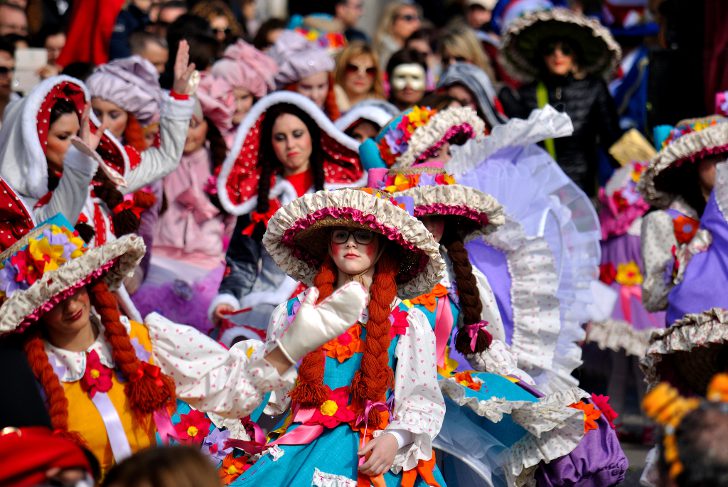The Carnival of Manfredonia (Carnevale di Manfredonia) isn’t one of the oldest Italian carnivals – it has been held in its modern form since 1952 – but it is certainly one of the most importance ones. It is recognized as an “event of regional interest” by the Apulia (Puglia) region and as a “historic carnival” by the Ministry of Culture of Italy. It is also a founding member of Carnevalia, an association of Italian carnivals that unites historic Carnivals in Foiano della Chiana, Viareggio, Putignano, Venice, Acireale, Sciacca, and other Italian cities and towns.
The carnival season in Manfredonia kicks off on January 17, the feast day of Saint Antony the Great. Also known as Sant’Antonio Abate (Saint Anthony the Abbot), he is venerated as a patron saint of animals and farmers. In Manfredonia, Saint Anthony’s day is referred to as “Sant’Andunje, masckere e sune!” in the local dialect, which means “Saint Anthony, masks and sounds!” and is a reference to the beginning of the annual Carnival. On this day, the organizing committee unveils the theme and program of the upcoming Carnival, as well as its special guests.
The festivities begin with the arrival of Ze Pèppe, the allegorical mascot of the Manfredonia Carnival. Ze Pèppe is a cheerful peasant who comes to town to have fun during Carnival. He usually has a mustache and wears a shabby shirt, a patched jacket and trousers, and a moth-eaten hat. Traditionally, he parades through town every Saturday, announcing the beginning of the weekend’s festivities.
The program of the Manfredonia Carnival usually includes several big parades with allegorical floats and masks. The central event of Carnival is the Grand Parade of Wonders that features thousands of children from local kindergartens, primary schools, and lower secondary schools. Since 1998, it has been held under the patronage of UNICEF.
The boisterous Parade of Wonders is usually held on the Saturday before Fat Tuesday. It is followed by the parade of allegorical papier-mâché floats and masked groups held on Sunday. The last parade of the Manfredonia Carnival is the Grand Parade of the Golden Night, a nighttime parade held on Fat Tuesday.
The final event of the Manfredonia Carnival is the cremation of Ze Pèppe. As legend goes, Ze Pèppe celebrates so hard that he eventually catches pneumonia and dies. His body is burned on the pyre at the end of Carnival as a symbol of renewal and rebirth, and then the Lent begins.
The Carnival of Manfredonia is also associated with traditional foods such as farrata and scagliozzi. The farrata (farrét in the local dialect) are round savory pies filled with a mixture of spelt and ricotta spiced with marjoram and cinnamon. The scagliozzi (scagghjuzz in the local dialect) are triangular slices of polenta (boiled cornmeal) fried in boiling oil.

Photo: Dauno Settantatre




